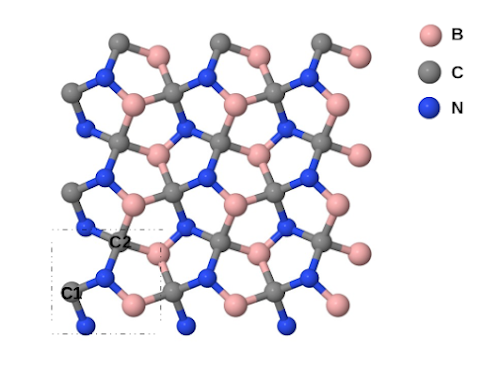A recent study by researchers Shambhu Bhandari Sharma, Ramchandra Bhatta, Rajendra Adhikari, and Durga Paudya has revealed the intriguing properties of a new ternary pentagonal prototype called pentagonal boron nitrogen carbide (p-BCN). The study, which was performed using density functional theory (DFT) calculations, found that p-BCN is a mechanically, thermally, and dynamically stable direct bandgap semiconductor with excellent piezoelectric response.
This new material, composed of B, N, and C atoms, has an almost equivalent atomic size and mass, making it lightweight and benign to the environment. The study found that p-BCN exhibits intrinsic polarization and piezoelectricity, as well as lattice thermal conductivity up to 97.49 at room temperature. Additionally, hydrogenation of the pristine p-BCN changes it from a direct bandgap of 1.70 eV to an indirect bandgap of 4.46 eV. The bandgap of hydrogenated p-BCN is tunable up to 3.26 eV under biaxial strain.
The researchers found that p-BCN is an excellent optoelectronic material due to its favorable surface for photon-electron interaction. The study predicts that p-BCN has excellent optical response, including a good static dielectric constant and refractive index, strong optical absorption with small energy loss, and reflectance peaks in both visible and ultraviolet regions. The anisotropic geometry of p-BCN also leads to strong optical anisotropy behavior in the monolayer. While the study did not perform a meticulous analysis of the optoelectronic properties of p-BCN, the researchers believe that their findings on the exceptional physical and chemical properties exhibited by the p-BCN monolayer make it a proper candidate material for nanomechanical and optoelectronic device applications. In conclusion, the study highlights the potential of p-BCN as a stable direct bandgap semiconductor with excellent piezoelectric and optoelectric properties, making it a promising material for use in a variety of applications in the fields of nanomechanics and optoelectronics.
Reference:
(1). Sharma, S. B., Bhatta, R., Adhikari, R., & Paudyal, D. (2022). Strain dependent electronic and optical responses of penta-BCN monolayer. Carbon Trends, 7, 100162.

Comments
Post a Comment